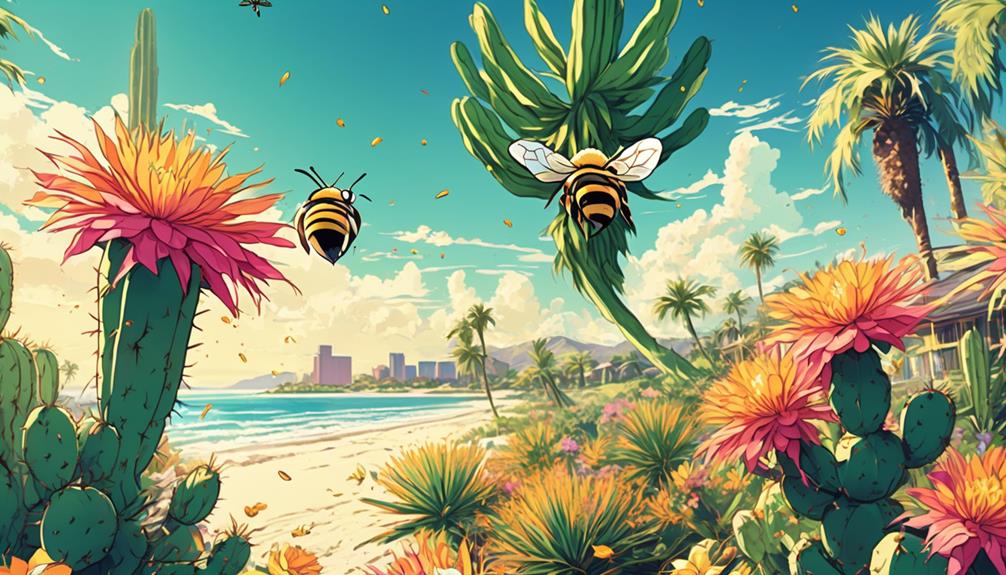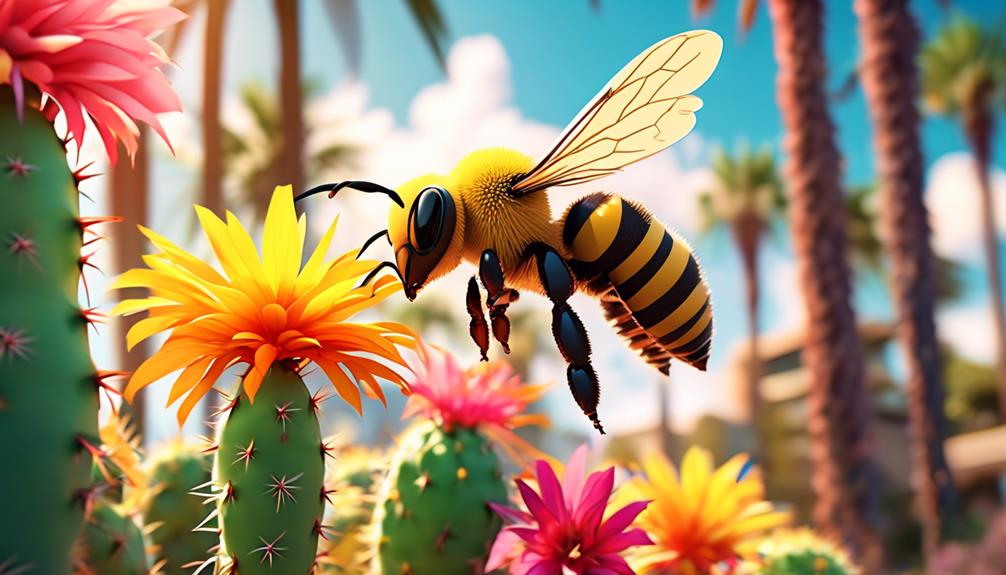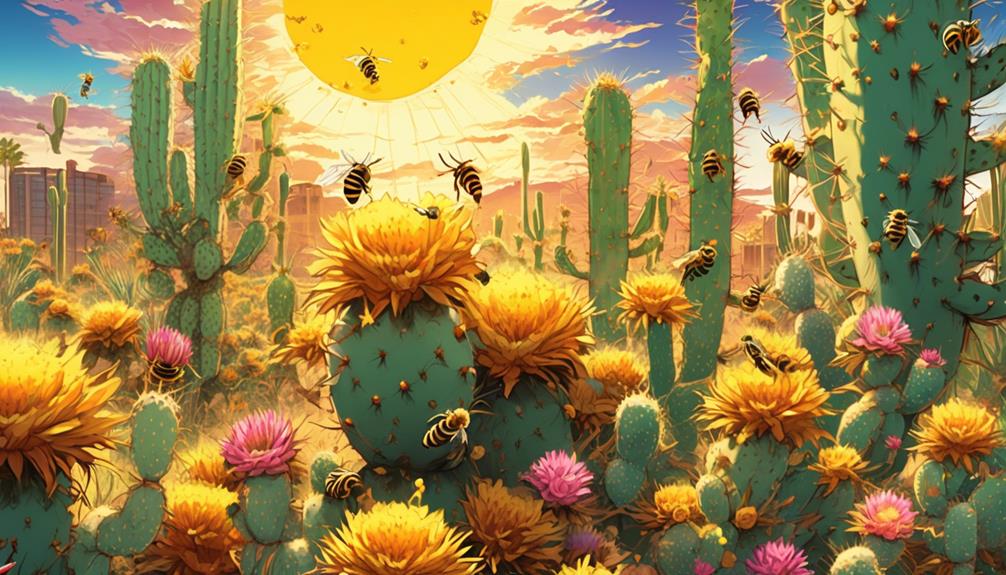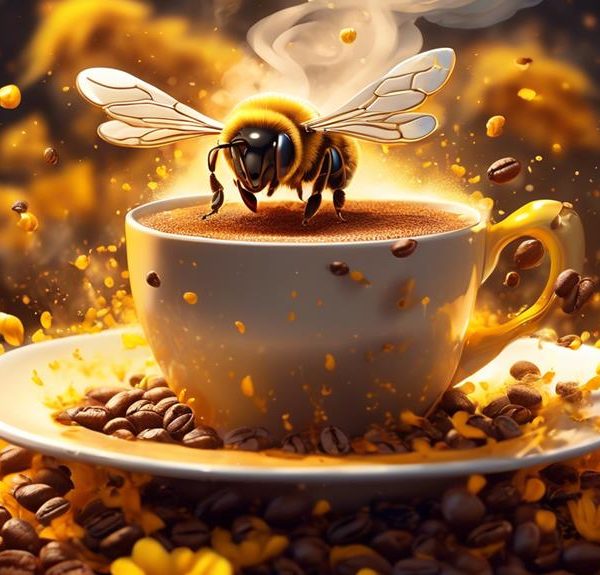Get ready to uncover the surprising relationship between bees and cacti in Florida's unique ecosystem.

Do Bees Like Cactus in Florida
Despite your initial thoughts, it's not a ridiculous question to ask if bees in Florida are attracted to cacti. You might associate bees more with flowers and lush greenery, and cacti with arid, desolate landscapes. However, Florida's unique ecosystem creates an intriguing blend of these elements which might not typically cross paths.
As you journey through this discussion, you'll uncover the surprising interactions between bees and cacti in the Sunshine State. The information might just challenge your preconceived notions, leaving you eager to explore further.
Key Takeaways
- Bees and cacti in Florida have a symbiotic relationship, where bees pollinate cacti and cacti provide food and nesting sites for bees.
- Cacti flowers provide a diverse diet for bees, with large quantities of nectar and pollen.
- This interaction between bees and cacti contributes to the stability of bee populations in Florida.
- Not all bees are honeybees and not all cacti produce flowers or nectar, but other insects and birds also play a role in pollinating cacti.
Understanding Bees in Florida

To truly appreciate Florida's diverse ecosystem, you must delve into the intricate world of its indigenous bees, where over 300 species buzz amidst the state's lush flora. You'll find the tiny, solitary, ground-nesting bees such as the Southeastern blueberry bees, which focus on pollinating specific plants. You'll also encounter the large, social honeybees, brought over by European settlers, that have now become integral to our agriculture.
Understanding these bees isn't a mere hobby; it's an essential scientific pursuit. Bees are vital pollinators, and their behavior often serves as an indicator of environmental health. They're also a keystone species, meaning their actions significantly affect the ecosystem.
In Florida, bees face threats from habitat loss, pesticides, disease, and climate change. You'd notice that many species are already endangered. The Miami blue butterfly, for instance, relies on bees to pollinate its food source, yet it's now nearly extinct due to the decline in bees.
Cacti in Florida's Ecosystem

In the vast expanses of Florida's diverse ecosystem, you'll also discover a stunning array of cacti, each playing a unique and crucial role in the overall health and balance of the region. These succulent plants, well-adapted to the dry, sandy soils of Florida, contribute to the biodiversity and provide shelter and food for numerous species, including bees.
Consider the prickly pear, the barbed-wire cactus, and the semaphore cactus, each with their distinct characteristics and functions within the ecosystem.
Cactus Species | Description | Ecological Role |
|---|---|---|
Prickly Pear | Characterized by its flat, fleshy pads. | Provides food for animals and humans alike. |
Barbed-wire Cactus | Recognized by its dense spines. | Offers shelter to insects and small birds. |
Semaphore Cactus | Known for its tall, columnar structure. | Serves as a pollination site for bees and other insects. |
You'll find that Florida's cacti not only add to the state's natural beauty, but also play key roles in maintaining the health of the ecosystem. Their importance underscores the need for their conservation, ensuring that they continue to thrive and support the region's vibrant biodiversity.
Interaction Between Bees and Cacti

You might be surprised to learn that bees and cacti share a significant, symbiotic relationship in Florida's ecosystem, with each playing a pivotal role in the survival and success of the other. Florida's cacti, particularly the prickly pear, bloom with vibrant flowers that produce nectar and pollen, a food source that's crucial for bees. In turn, bees play a vital role as pollinators, helping these cacti reproduce.
When bees visit these blossoms for nectar, they're inadvertently dusted with pollen. As they buzz off to the next flower, some of this pollen rubs off, fertilizing the new blossom and initiating the formation of fruit and seeds. This interplay is essential for the propagation of cacti species in Florida.
But it's not just a one-way street. When bees collect nectar and pollen, they're also gathering food for their hives. The nectar, packed with sugars, provides energy, while the pollen offers proteins and fats necessary for bee larvae growth.
This mutualistic relationship ensures the continuity of both species. So, you see, bees and cacti in Florida aren't just co-existing – they're interdependent, each contributing to the other's survival in a delicate ecological balance.
Impact of Cacti on Bee Populations

The symbiotic relationship between bees and cacti in Florida has a profound impact on the bee populations. Cacti flowers serve as a reliable and rich food source for these vital pollinators. During the blooming period, cacti produce large quantities of nectar and pollen, providing bees with a substantial supply of food.
This is more than just a casual interaction; it's an integral part of the survival strategy for bees, especially when other food sources are scarce. Bees require a diverse diet to thrive, and cacti play a role in this nourishment.
But it's not just about food. The structural design of cacti also provides safe havens for bees. The bees often nest in the hollows of cacti, protecting their colonies from predators and harsh weather. This housing opportunity contributes to the stability of bee populations in Florida.
Addressing Common Misconceptions

Despite prevalent misconceptions, bees aren't merely opportunistic feeders nor do cacti solely rely on these pollinators for reproduction. Bees, especially honeybees, are selective feeders. They prefer nectar-rich plants, and cacti aren't always their first choice. Cacti, on the other hand, are adapted to harsh environments and can reproduce through self-pollination or by wind, if bee pollinators are absent.
To better grasp these concepts, let's break down some common misconceptions:
Misconception | Reality |
|---|---|
All bees are honeybees | Many different bee species exist, not all produce honey |
Bees only feed on flowering plants | Bees can also feed on tree sap, fruits, and other sources |
Cacti solely rely on bees for pollination | Cacti can self-pollinate or rely on wind |
All cacti bloom and attract bees | Not all cacti produce flowers or nectar |
Bees are the primary pollinators of cacti in Florida | Other insects and birds also pollinate cacti |
Frequently Asked Questions
What Are the Different Types of Bees Found in Other Parts of the United States?"
You'll find various types of bees across the United States.
In the East, you'll commonly see the Eastern Carpenter Bee and the Blue Orchard Bee.
The Midwest is home to the Rusty Patched Bumble Bee, while the West hosts the Western Honey Bee.
Down South, the Southern Carpenter Bee buzzes about.
Each of these bees plays a vital role in their respective ecosystems, contributing to plant pollination and growth.
Are There Any Other Insects That Interact With Cacti in Florida?"
Indeed, various insects interact with cacti in Florida, not just bees. You'll find cactus bugs, which feed on the plant juices, and the cactus moth, whose larvae can devastate cacti populations.
Ladybugs too are common, they prey on aphids found on these plants. Weevils and beetles also feed on cacti.
It's a complex ecosystem, with each insect playing a role in the life cycle of cacti, beyond just pollination.
How Does Florida's Climate Affect the Growth of Cacti?"
Florida's climate greatly influences cacti growth. You'll find that the high humidity and rainfall can cause issues, as cacti prefer drier environments. However, they can adapt to the sandy soil and intense heat.
Overwatering or poor drainage can lead to root rot. So, it's essential that you manage the watering cycle and ensure good soil drainage to help your cacti thrive in Florida's conditions.
What Other Plants Do Bees in Florida Typically Prefer?"
You're curious about the plant preferences of Florida's bees. They typically favor native plants like Spanish Needles, Tickseed, and Bee Balm. These plants provide nectar and pollen, crucial for their diet.
However, they're also attracted to non-native plants like citrus trees. It's important to remember, bees aren't particularly picky; they'll visit any plant that meets their nutritional needs. So, while cacti aren't their first choice, they wouldn't turn their noses up at them either!
Are There Specific Types of Cacti That Are Harmful to Bees?"
You're asking if certain cacti are harmful to bees. It's crucial to note that bees aren't typically harmed by cacti. They're attracted to many flowering cacti for their nectar.
However, the spines can pose a physical threat if bees accidentally impale themselves. But remember, bees are skilled navigators and usually avoid such hazards.
Conclusion
In conclusion, bees in Florida do interact with cacti, but it's not their preferred choice. While cacti contribute to Florida's ecosystem, they don't significantly impact bee populations.
Misconceptions about bees and cacti often arise due to a lack of understanding. Remember, it's the diversity of flora that ensures a healthy bee population, not just one type of plant.
So, while cacti mightn't be a bee's best friend, they do play a role in Florida's intricate ecosystem.


